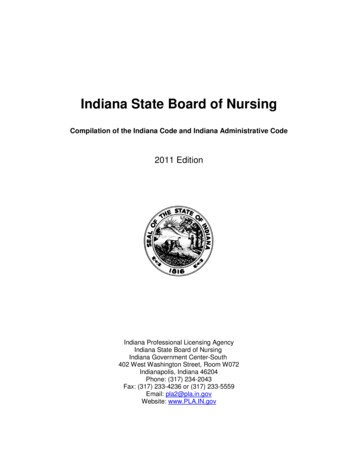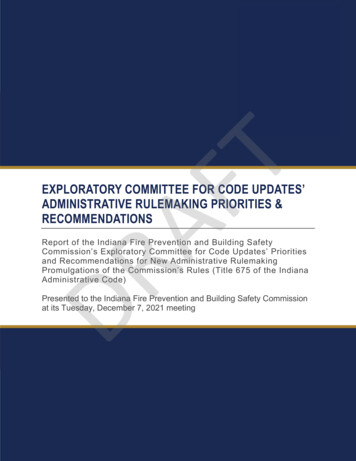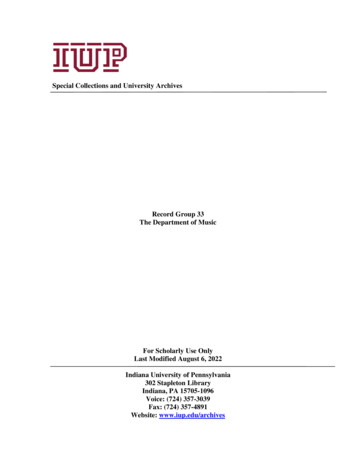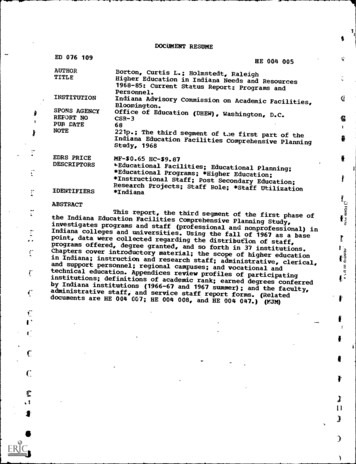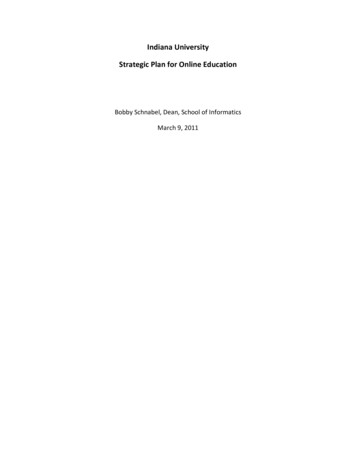
Transcription
Indiana UniversityStrategic Plan for Online EducationBobby Schnabel, Dean, School of InformaticsMarch 9, 2011
Letter of Transmittal2
Charge from President McRobbie3
4
Contents1.2.3.4.Summary of Main RecommendationsPreambleGuiding PrinciplesAcademic Issues4.1. Curriculum4.1.1. Undergraduate Programs and Courses4.1.2. Graduate Programs and Courses4.1.3. Summer Courses4.1.4 Hybrid Courses4.2. Faculty Issues4.3. Course Delivery and Support5. Policy Issues5.1. Intercampus Issues5.2. Pricing5.3. On‐Campus Component6. Structure and ManagementAppendicesA. People and Groups ConsultedB. Supporting Data and Information (separate document)a. Online Degree Programs and Coursesi. National Table by Disciplineii. IU Online Programs and Courses1. ICHE approved programs2. Online Summer Coursesiii. IU Summer Course Enrollmentb. IU Online Enrollmentsi. Total Enrollment Online Education and Traditional Enrollment by Campusii. Portion of Online Students by IU Region Designationsiii. Faculty Teaching Online Courses at IUc. Pricing Informationi. Specific Pricing Information at IUii. IU Pricing Policies – Summaryiii. Pricing Summaries for Other Universitiesd. Data Challenges with Online Education at IU5
1. Summary of Main Recommendations Guiding Principles:o Quality expectations for IU online education should be equivalent to those for on‐campus education. Criteria for selection of faculty to teach online courses should bethe same as for on‐campus courses.o Academic control of online courses and programs should be equivalent to that for on‐campus education.o IU’s primary market for online education should be its natural markets includingresidential students, students in campus regions, and Indiana citizens and professionals.o IU online education should combine the best features of IU on‐campus education withthe best capabilities of IU’s renowned technological infrastructure.Undergraduate Education:o The foremost reasons for delivering undergraduate courses and programs online arefacilitating timely progress to earning degrees; providing convenient access to educationfor students, particularly working adults; and facilitating retention. The most importantneed and opportunity for undergraduate online education is to offer alternative sectionsof popular undergraduate courses. The provision of entire undergraduate degreeprograms online is not expected to be a major IU focus in near future.o IU should consider opportunities where a multi‐university consortium approach toproviding common undergraduate courses would offer advantages of quality and cost.Graduate Education:o A primary reason for offering graduate courses and programs online is to meet theneeds of Indiana residents, particularly working professionals, who are seekingcontinuing education in their fields, as well as citizens who cannot get to universitycampuses and seek graduate education in fields where the market is large enough tosupport an online degree. A second opportunity is in areas where IU has sufficientnational and international distinction, or offers a sufficiently unique and usefulcurriculum, that it can attract new markets of students, within and outside of Indiana.o IU’s current online offerings at the graduate level match up well with national patterns;there may be additional opportunities in areas including computing, engineering, andfurther areas in the health sciences and in education.o IU may want to consider an expedited approval process for online graduateprofessional certificates so that they can be responsive to societal needs, with acorresponding review/sunset process.Course Support:o IU needs to devote resources to instructional design support for online education,technology support that meets the 24/7 needs of online students, and enhancement ofOncourse to provide the capabilities and flexibility to support IU online education well.6
Intercampus Issues:o IU campuses do not, in general, feel threatened by online offerings from other IUcampuses. The regional campuses and IUPUI generally feel that their online coursesprimarily serve a regional market and data mainly supports this.o There is a clear need for a high level IU administrator to serve as a “gatekeeper” tooversee intercampus issues regarding online offerings.o IU’s organizational and fiscal infrastructure to support multi‐campus courses isinsufficient and requires attention.Pricing:o IU needs to educate policy makers and the public that online education generally ismore, not less, expensive than on‐campus education at both undergraduate andgraduate levels, primarily due to the fact that equivalent quality online educationrequires greater individual student attention than on‐campus education.o IU should price undergraduate online education at least as high as on‐campusundergraduate education, for both in‐state and out‐of‐state students, generally with anadditional fee to support the increased cost of online instruction. At the graduate level,there needs to be flexibility for units to set pricing that they feel is competitive for theirmarket. Graduate tuition rates for out‐of‐state online students should be higher thanin‐state rates, but often may not be as high as on‐campus out‐of‐state rates.o IU needs a clear and consistent policy about additional fees for online students.Structure and Management:o IU needs a small office that provides leadership and management of online education.A portion of the responsibilities of this office go on indefinitely, while other parts shouldbe needed only for a few years. It should be led by a respected academic.o The primary duties of an office of online educations should include: strategic oversightof IU’s online education activities; serving as the “gatekeeper” for intercampus issuesregarding online education, and as the point of final decision making (subject topresidential and Trustee approvals) upon input from the IU Academic LeadershipCouncil; maintaining an IU portal for all IU online education offerings; coordinating withstate and other entities that influence online education. Additional responsibilities inits first few years should include: working with campuses, colleges and schools toencourage exploration and implementation of programs that are consistent with IU’sonline education strategic plan; determining overall university resource needs tosupport online education, needs of specific units, and ways to meet these needsincluding a pricing policy for IU online education; leading an IU conversation of criteriathat should be used to assess new online degrees and programs; defining IU’s datacollection needs related to online education and assuring that they are met; workingwith the bursar, registrar and other key units to improve the ease and efficiency ofsupporting multi‐campus courses and programs.7
2. PreambleOnline education has exploded in the United States in the past 10‐15 years. The number of post‐secondary students taking at least one online course grew from 1.6 million (9.6% of the total enrollmentof 16.6M) in fall 2002 to 5.6 million (29.3% of the total enrollment of 19.0M) in fall 2009 – a compoundgrowth rate of 19%/year for online enrollment vs. 2%/year for overall enrollment. During this era, afew universities have succeeded as new for‐profit online universities (e.g. U. Phoenix) or have developedlarge new online businesses (UMass Online, Penn State World Campus) while a number of ventureseither have failed or been significantly reoriented (e.g. AllLearn (Oxford, Stanford, Yale), Columbia, U.Illinois, U. Maryland, New York University, U. Texas). (The preceding data is taken from a recent SloanFoundation study; in a bit of a tautology, it defines an online course as one that is delivered at least 80%online, although our sense is that most online courses are delivered entirely online.)Indiana University has developed significant online offerings in recent years. The percentage of onlinecourse enrollments in fall 2010 ranged from 0.9% at IU Kokomo and 2.8% at IU Bloomington, to 3.7%,4.0% and 4.8% at IU South Bend, Northwest and Southeast, respectively, to 12.6% at IUPUI and 28.4% atIU East. IU has developed distinctive, successful online programs in areas including business (KelleyDirect), nursing and education. The School of Continuing Studies also has developed a wide range ofonline offerings, including the Bachelor of General Studies degree. (The percentages above includeSchool of Continuing Studies online courses taught through the campuses.) IU East has placed greatemphasis on online education in the past few years, while units such as the College of Arts and Sciencesat IU Bloomington, SPEA, and IU Kokomo have increased their attention to online education recently.IU does not, however, have a current comprehensive strategic plan for online education. (An IU‐Bloomington “E‐Learning Task Force Report”, chaired by Prof. Anne Massey, was produced in June 2010;earlier studies include the report of a university‐wide distributed education committee chaired byAssociate Vice President Erwin Boschmann in 2000, and the report of the President's AdvisoryCommittee on Distance Education, chaired by Dean Blaise Cronin in 1997.) This plan is needed for twomain reasons. First and foremost, IU needs to be sure that it is availing itself of opportunities to betterserve its existing students and to develop attractive new programs by using online delivery, and that it ismaking a well‐considered response to new competition from outside online offerings. Secondly,administrative and management issues in areas including interactions between online offerings atmultiple campuses, pricing of online courses, and the management of IU’s online enterprise requireuniversity‐wide planning and attention.It should be emphasized at the outset that this strategic plan does not signal any fundamental change inIU’s educational philosophy and approach. Personal interaction remains and will remain a crucial partof learning, and for the foreseeable future, most often will be accomplished best in a face to facesetting. The residential university as embodied by the physical infrastructure of IU’s campuses providesvalue in many ways within and outside the classroom, and is expected to endure and thrive. Onlineeducation offers advantages of access and convenience, and is well suited to content in some areas.This plan assumes that online education at IU will complement an undiminished commitment to on‐campus education.8
Finally, it should be acknowledged upfront that collecting data about online education presentschallenges and uncertainties, both at IU and at other institutions. The main reasons for this include: There is no uniform definition of what is considered an online course, particularly for coursesdelivered primarily but not fully online, and no guarantee of a fully accurate record of which areonline courses, even when a definition is agreed upon.There are not necessarily complete listings of what degrees and programs are offered online bya given university and no uniform definition of this category either, particularly for programswhere most but not all components are taken online.Counting online students is particularly unclear – definitions can include students who areenrolled in any online course although that student also may be taking on‐campus courses atthe same time, students who take the majority of their coursework online in a given semester(the definition generally used at IU), and students enrolled in an online degree or certificateprogram.At IU, the School of Continuing Studies is a separate organization with a significant onlinecomponent, but its courses are offered through the IU campuses. Thus the campus’ online dataincludes enrollments in both School of Continuing Studies’ online courses offered through thatcampus, and online courses offered directly by the campus’ schools and colleges, and there is noeasy way to separate the two categories. Moreover, the School of Continuing Studies is notfully integrated into the university’s student enrollment system, which compounds the dataproblem.The preceding points are elaborated upon further in the discussion of data challenges in onlineeducation at IU at the end of Appendix B. All of these uncertainties lead to the understanding thatwhile the IU and national online education data is sufficient to identify overall trends and to guide highlevel strategic recommendations, it has limitations in terms of drawing more detailed conclusions.9
3. Guiding PrinciplesIU’s online educational offerings should adhere to the following general academic principles. Thereappears to be broad agreement on these principles across the university. Quality expectations for online education should be equivalent to those for on‐campuseducation. As part of this, criteria for selection of faculty to teach online courses should bethe same as for on‐campus courses.Academic control of online courses and programs should be equivalent to that for on‐campus education; online education simply should be considered a different deliverymechanism by standard academic units. Similarly, support services such as registrar, bursarand advising should be provided by existing structures unless there is a clear advantage tooffering them separately for particular programs.The primary market for online education should be IU’s natural markets including residentialstudents, students in the region of the campus, and Indiana citizens and professionals.Generally, programs that seek to develop markets outside of these categories should beones that have a particularly strong national and international reputation, or that offer aparticularly unique curriculum.Online delivery should be selected primarily in cases when it is equally or better suited tohigh quality educational outcomes for the particular course or program in comparison to on‐campus delivery. IU online education should combine the best features of IU on‐campuseducation with the best capabilities of IU’s renowned technological infrastructure.In addition, the following broad principles should characterize IU’s online offerings at theundergraduate and graduate levels. These principles also appear to be broadly agreed upon. The primary goal of offering undergraduate courses and programs online should befacilitating timely progress towards graduation. Important aspects of this include providingadditional access to popular courses, both in normal semesters and in the summer, andproviding online programs in cases where the student audience, although regional, is morelikely to be able to access education online than on‐campus.The primary goals of offering graduate courses and programs online should includeenhancing access to Indiana students, particularly working professionals seeking continuingeducation in their fields and Indiana citizens who are remote from university campuses, andexpanding markets and/or student quality for distinguished or unique IU academicprograms.10
4. Academic Issues4.1. Curriculum4.1.1. Undergraduate Programs and Courses The primary reasons for delivering undergraduate courses and programs online arefacilitating timely progress to earning degrees; providing convenient access to education forstudents, particularly working adults; facilitating retention (particularly for the regionalcampuses); mitigating classroom space constraints; and providing an IU online alternativefor popular courses that are offered by other online providers. New revenue is not theprimary motivation for many online undergraduate offerings, but undergraduate onlineofferings may allow campuses to expand enrollment beyond the limitations of availableclassroom space, and to serve student markets that would not come to campus. Theseopportunities are growing because students are becoming increasingly comfortable withonline technology and with enrolling in online courses.The most important need and opportunity for undergraduate online education is to offeralternative sections of popular undergraduate courses (often large enrollment and/orbottleneck courses), so that students have more varied access to these courses. IU East’semphasis on online education includes this aspect; IUPUI does this to some extent and is inthe process of expanding in liberal arts; IU Bloomington is about to develop and pilot anumber of such courses in the College of Arts and Sciences; and IU Kokomo also is engagedin developing such courses. IU should continue to look carefully at student needs andexternal forces in this area, on all of its campuses.IUPUI has had some negative experiences with low‐level undergraduate students havingpoor success rates in online courses, and feels this was due to student maturity not fittingwell with the online style of education. While this experience is not uniform at IU, it is animportant caution: particularly for relatively inexperienced undergraduate students, onlineeducation must provide sufficient contact, information and support to assure that theythrive in this style of education.The provision of entire undergraduate degree programs online was not a significant focus ofthis study and is not expected to be a major IU focus in near future. (This is consistent withthe guiding principle that IU should focus on improving its service to its natural markets,rather than developing entirely new markets.) Beyond the Bachelor of General Studies, IUoffers a small number of undergraduate degree programs online (see listing of IU onlineprograms and courses in Appendix B; note that in addition to the IU‐wide nursing RN to BSNdegree, only four IU East degrees are offered entirely online, Business Administration (B.S.),Communication Studies (B.S., B.A.), English, Technical and Professional Writingconcentration (B.A.), and Natural Science and Mathematics, Mathematics concentration(B.A.)). The most likely market for entirely online undergraduate degrees is professionalprograms that appeal largely to working adults.11
IU should consider opportunities where a multi‐university consortium approach to providingcommon undergraduate courses would offer advantages of quality and cost. The naturalgroup to work with to develop and experiment with such an approach is the CIC universities.In the long run, such an approach may be necessary to remain competitive with for‐profitproviders, while offering academic quality and control. (The CIC CourseShare programalready shares access to specialized courses among CIC universities.)4.1.2 Graduate Programs and Courses A primary reason for offering graduate courses and programs online is to meet the needs ofIndiana residents, particularly working professionals, who are seeking continuing educationin their fields, as well as citizens who cannot get to university campuses and seek graduateeducation in fields where the market is large enough to support an online degree.A second, more restricted opportunity for online graduate programs is in areas where IU hassufficient national and international distinction, or offers a sufficiently unique and usefulcurriculum, that it can attract new markets of students, within and outside of Indiana.These opportunities offer programs the ability either to increase enrollments and/or toincrease the quality of their student body.Decisions about offering graduate courses or programs online are best left to the schools orcolleges, as they are in the best position to assess the markets and the appropriateness oftheir curriculum to online delivery.A national table of programs that are most commonly offered online (see “National Table byDiscipline” in Appendix B) shows that the leading programs are business and management,education and training, computer science and information technology, engineering andelectronics, and healthcare and medical. IU’s online offerings at the graduate level matchup well with this list, particularly in business, education, nursing, and informatics, and thelist does not show any glaring omission. There may be additional opportunities in several ofthese areas, including computing, engineering, and possibly additional areas in the healthsciences and in education.Issues of flexibility are particularly important in graduate online education and werementioned by most of the current online graduate programs. Key instances include:pricing; academic calendar; course management systems. Each of these is addressed laterin this document.IU may want to consider an expedited approval process for online graduate professionalcertificates, so that they can be responsive to societal needs, with the understanding thatsuch certificates would be reviewed after several years and allowed to sunset if the need nolonger exists or the demand has not been sufficient. (Note that ICHE approval is required toprovide students access to federal and state financial aid programs.)4.1.3 Summer Courses There is a perception, particularly at IU‐Bloomington, that students are takingundergraduate courses from other providers in the summer, either online or in their home12
area, and then transferring these to IU. IU currently does not offer many high‐demandundergraduate courses online in the summer, and should consider which courses havesufficiently large potential demand that it should offer them online in the summer.Data collected from CIC institutions show that some offer many undergraduate coursesonline in the summer (Michigan State, Minnesota) while others offer very few (Ohio State,Penn State, Purdue, Wisconsin). By ramping up this activity, IU would be in a reasonableposition relative to its CIC peers. Conversely, if IU does not offer such courses, onlinecourses already offered by other universities will provide attractive and good qualityalternatives to attract our students.4.1.4 Hybrid Courses The timeframe of this study did not permit an in‐depth examination of the possibilities forblended on‐campus / online instruction. It did reveal, however, significant interest in andopportunities for this approach. The motivation generally combines three factors: a portionof the course material is well suited to online education; the blended approach makes moreefficient use of scarce classroom space; the blended approach saves non‐residentialstudents trips to campus. Examples that were cited where this approach is potentiallyattractive include introductory physics courses at IUPUI where much of the laboratorycomponent can be provided at least as effectively via computer simulations, and thepopular Traditions and Cultures of IU course at IUB where a virtual rather than physical tourof the art museum would allow the course to serve more students. IU Southeast expressedparticular preference for hybrid courses as opposed to fully online courses. A partialexamination of bottleneck courses at IU campuses indicated that laboratory space forundergraduate science courses was a frequent limiting factor, so that a hybrid approachthat utilizes virtual laboratories where appropriate could improve the ability to satisfystudents’ course needs.4.2. Faculty Issues The expectations for the qualifications and status of faculty teaching online courses shouldbe the same as for on‐campus courses. There is broad agreement on this point from IUschools, colleges and campuses. Data from IU‐Bloomington, IUPUI and IU East indicate thatcurrently, the percentage of regular faculty (including both tenure and non‐tenure track)teaching online courses is quite similar to the percentage teaching on‐campus courses. (Seedata on faculty teaching online courses at IU in Appendix B.)There should be flexibility as to how an online course counts in the faculty member’steaching load. There is consensus that the per student time demand of online teachingexceeds that of on‐campus teaching. Some units mitigate this with smaller enrollmentsand/or more instructional assistant support, and count the course normally. Others insteadcount an online course as 1.5 or in at least one instance, 2 on‐campus courses in the facultymember’s teaching load. This decision seems best left to the resource center unit.13
In keeping with online education being an integral portion of IU’s overall educationofferings, in general it is preferable for online instruction to be considered a part of thenormal faculty teaching load rather than an overload. An exception is cases where theonline program serves markets where enrollment may fluctuate markedly from one year tothe next; in this case using overloads may be appropriate. The Kelley Direct program is anexample of this phenomenon, particularly due to its corporate audiences which candramatically increase or decrease student enrollment with little advanced notice. Overloadsalso may be appropriate in cases where they are the only way to meet student demand withhigh quality faculty in the short term due to the market for faculty in that area.It is appropriate to provide start‐up support for faculty for the development of a new onlinecourse. The most successful model has been small summer grants, with payment tied atleast in part to the completion of the course materials.4.3 Course Delivery and Support A very wide range of approaches to online course delivery are used successfully at IU.These range from online courses taught in tandem with on‐campus courses where an on‐campus class is recorded and provided online, to courses that are only offered online butinclude some lecture component, to online courses that consist entirely of instructionalmodules, exercises and group experiences customized to the online environment. Thechoice of what is most effective is tied heavily to the course content.In all cases, two types of support are imperative for online education. The first isinstructional design support to understand what approaches are best suited to that courseand aid in the development of the course materials. The second is technology support,which must include a 24/7 component in recognition that online students expect access atany time that they are able to devote attention to the course. IU needs to devote resourcesto both of these needs (this is related to the pricing discussion later in this report). IUshould benchmark itself against peer institutions with successful online programs to helpdetermine the correct support levels. IU also should take care to assure that its onlinecourse materials and its websites and materials that support online education are fullyaccessible to students with disabilities.While some units that have large online programs (e.g. Kelley School of Business, School ofNursing) have their own support staff for instructional design and technology support, it iscrucial that IU provide these resources in general. Currently, very little support frominstructional designers with experience in online course development is available as ashared resource on IU campuses, and there is a clear consensus from both the academic andsupport sides that more is needed. This need is beginning to be addressed at IUBloomington. As more instructional designers for online education are hired, IU may wantto consider a structure where they are part of a central campus group but are located in andserve specific schools and colleges.Attention needs to be given to how the Oncourse system can best provide the capabilitiesand flexibility to support IU online education well, and resources to enable this to be done14
need to be provided. Oncourse is used by most units and is expected to play the key role insupporting IU online courses in the future. Enhancements that were broadly suggestedinclude: the ability to treat a multi‐campus course as a single Oncourse course; the ability towork well with courses taught outside normal semester boundaries; 24/7 support; increasedsupport for the types of collaborative online activities that are an important part of onlineeducational pedagogy. IU would benefit from ongoing collaboration between technologyleaders and representative faculty on these issues, leading to an agreed upon priority fordevelopment activities.15
5. Policy Issues5.1. Intercampus Issues One issue this study examined was whether the marked increase in online offerings by oneregional campus (IU East) was creating issues for other campuses. From talking to the othercampuses, this does not appear to be the case –none of campuses appear to feel threatenedby online offerings from other IU campuses. The regional campuses and IUPUI generallyfeel that their online courses primarily serve a regional market. The available data (see dataon online enrollments by IU region designation in Appendix B) indicate that this ismoderately true – for example for IUPUI and IU East, the percentages of online studentsfrom their region, other IU regions, Indiana but no IU region, and out of state are58%/7%/9%/21% and 54%/13%/11%/21% respectively. (IU East data for spring 2011 showthat of students taking at least one online course this spring, 79% are from their serviceregion. The majority of these are taking on‐campus courses as well. As mentioned in thepreamble, the percentages above refer to students taking the majority of their credit hoursonline. As also stated in the preamble, conclusions from this data should be drawn at abroad level only.)To the extent that IU degrees, online as well as residential, are identified with a particularcampus, it may not be necessary to view overlapping online degrees much differently thanwe view overlapping on‐campus degrees. (Currently, degrees are differentiated by givingthe location (not campus) of the degree (on‐campus degrees only) and by the Chancellorwho signs them (all degrees).) For either online or on‐campus degrees, universityexamination of the need for degrees is needed, but with the understanding that often it isreasonable for multiple campuses to offer degrees in the same area. Online degreesshould be treated differently only under a clearly defined and understood set of criteria,s
Graduate tuition rates for out‐of‐state online students should be higher than . online, although our sense is that most online courses are delivered entirely online.) Indiana University has developed significant online offerings in recent years. . 4.0% and 4.8% at IU South Bend, Northwest and Southeast, respectively, to 12.6% at IUPUI .

